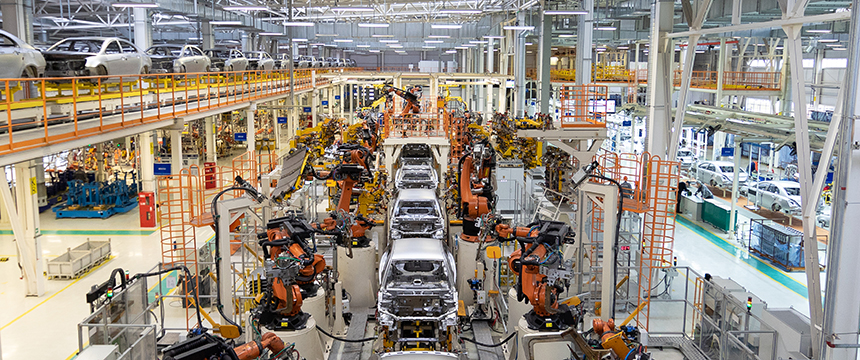MEMA Original Equipment Suppliers Annual Conference – Outlook Panel’s Economic and Growth Forecasts for the Automotive Industry

In a year of many global market challenges that have impacted the automotive industry, the MEMA Original Equipment Suppliers Annual Conference held on November 12 and 13 in Novi, Michigan presented a detailed analysis of the current situation and future outlook for the automotive industry. The conference brought together the supplier and OEM communities to foster connections at the core of the automotive world.
During its second day, the Outlook Panel moderated by Mike Jackson (Executive Director, Strategy & Research, MEMA The Vehicle Suppliers Association), in which Philipp Carlsson-Szlezak (Chief Economist, BCG), Jeff Schuster (Global VP of Automotive Research, GlobalData) and Emmanuel Rosner (Managing Director, Equity Research, Wolfe Research), provided their economic projection regarding the activity and growth of the automotive industry for the year 2025.
Mr. Jackson began the discussion with a review of the “challenging” market that suppliers find themselves in, including the risk of substantial stranded capital arising from the shortfalls in EV demand vs. the installed production capacity. According to MEMA’s most recent survey, supplier sentiment rests at 35, a pessimistic 15 points below a neutral level.
Mr. Carlsson-Szlezak began by sharing his insight into the current economy, including the various media predictions and false alarms that have contributed to a perceived troubled world economy in recent years.
The economic data coming out on the heels of the recent the US election show a rise in the price of equities, and the value of the dollar and bitcoin, but headwinds for the development of clean energy, according to Carlsson-Szlezak. The new Administration is not expected to show the same interest in climate change, which received a fiscal boost under the Biden Administration.
Mr. Carlsson-Szlezak went on to provide examples of how economic projections have typically failed historically, stating that the best way to read the economic situation is through narratives. The first narrative to consider is the soft landing[1], which consists of three stages: the slowdown in the labor market, inflation is in a stage of moderation, and the policy response is leaning towards neutrality.
Mr. Carlsson-Szlezak emphasized the importance of understanding the relationship between input prices and consumer wages, a concept referred to as “price affordability.” Over recent years, price affordability has shown significant improvement and continues to strengthen as an economic forecast. This trend is particularly evident in the automotive industry, which has seen substantial recovery and growth in both vehicle and parts affordability despite the frequently heard view that consumer affordability has deteriorated. “The story that only the rich can continue to spend does not add up,” he noted while also acknowledging some of the current headwinds. A noteworthy aspect contributing to this affordability improvement is the increase in competition, resulting in a deflationary effect on new vehicle prices, which can largely be attributed to excess production capacity.
However, as Mr. Carlsson-Szlezak pointed out, economic dynamics are complicated by the hard edges of a soft landing. The upward pressure on worker wages creates ongoing challenges for businesses that strive to meet these demands. This situation becomes further complicated by rising interest rates and extended payment terms, which further challenge companies’ financial health. As a result, there is an emerging need for debt restructuring, as longer maturities at higher interest rates have become increasingly common.
To navigate the economic challenges, Mr. Carlsson-Szlezak suggested that companies should focus on improving productivity at lower costs. He shared several examples of how the integration of applications and technology can enhance mobility, thereby fostering better operational efficiency and overall profitability.
Transitioning to the global perspective on the automotive industry, Mr. Schuster provided valuable insights during the panel´s discussion. He presented an overview of the current state of the industry, highlighting both risks and opportunities for future growth. Despite a reported 10% growth in the demand for light vehicles in early 2023, this momentum has gradually diminished over the course of the year (2024), culminating in a decline over the past three months compared to the previous year. Nevertheless, a slight uptick in sales is anticipated starting in October and Mr. Schuster predicted 2024 light vehicle sales in the U.S. to total 15.8 million units and 16.2 million in 2025.
One significant area of concern is the evident slowdown in electrification progress, resulting in the real problem of “too much capacity” according to Mr. Schuster. Yet, he remains optimistic, anticipating a doubling (sic) of sales in the electric vehicle segment within the upcoming months.
Regarding production levels globally, Mr. Schuster shared data indicating an overall negative trend within the industry. This downturn often results in excessive inventory levels and underutilized manufacturing capacity. China has emerged as a major player in bucking this trend, exhibiting the most significant growth in production over the past year, followed by Russia, India, and Mexico.
Mr. Schuster noted that significant disparities have arisen over the last five years among the top three light vehicle producing regions. China’s production has surged dramatically, with projections suggesting continued growth over the next five years. Conversely, North America has witnessed only negligible increases, and is expected to remain flat in the coming years. Europe, on the other hand, has experienced a marked downturn in the past two years, with projections indicating further declines by 2025, making it unlikely for the region to return to pre-pandemic production levels of light vehicles within this decade.
These trends can be attributed, in part, to the broader negative impacts stemming from Russian activity on the global stage, affecting growth prospects in Central and Eastern Europe. Additionally, unfavorable trade flows have arisen from the competitive pressures exerted by Chinese imports and protectionist policies limiting exports to North America.
Mr. Schuster concluded with an evaluation of the potential impact of U.S. elections on the automotive industry, trade relations and electric vehicles (including their regulatory frameworks). Trade shifts may substantially impact the U.S. market, as 25% of current sales stem from imports under the United States-Mexico-Canada Agreement (USMCA), with another quarter sourced from non-USMCA regions.
Should tariffs akin to those imposed during Trump’s administration be reinstated or expanded, vehicle prices could rise, posing additional risks to overall sales volumes. Escalated tariffs would likely provoke retaliatory measures from international trade partners, potentially weakening U.S. exports as well.
With regards to the electric vehicle market, the new U.S. Administration’s policies may either slow down or potentially reverse current emissions standards and introduce high tariffs on Chinese imports, according to Mr. Schuster. Additionally, limitations on imports through Mexico could drive up component prices and negatively affect electric vehicle production rates and automotive supplier profitability.
The next speaker was Emmanuel Rosner (Managing Director, Equity Research, Wolfe Research). Mr. Rosner noted that in recent years, the automotive industry has faced unprecedented challenges from a variety of fronts, particularly from an investor’s perspective, resulting in a conservative market outlook for auto equities. Investors are increasingly anxious about the current earnings levels and their potential decline, with some exceptions like Tesla and General Motors, which recently have managed to maintain more stable stock performance amidst turmoil. “Nearly all U.S. auto stocks have underperformed this year,” and some massively, according to Mr. Rosner.
A significant aspect of this shift has been caused by the loss of seven points of global market share by the top ten automakers, equating to roughly six million fewer units sold. This decline contrasts with the rise of new entrants in the market, such as BYD, Geely, Changan, Chery and SAIC, who have captured the others’ lost market share, driven by the growth of the Chinese market and competitive pricing.
Compounding these challenges is the apprehension regarding supply chain disruptions, particularly following China’s strategic move to establish manufacturing operations in Mexico. By doing so, Chinese automakers aim to supply the American market while circumventing the tariffs imposed by the United States. This development will play a significant role in the upcoming 2026 review of the USMCA.
In addressing the challenges highlighted, Mr. Rosner provided valuable insights into actionable strategies for suppliers. He emphasized the importance of diversifying their global customer base, especially by engaging with successful Chinese manufacturers.
Furthermore, with profit margins and returns coming under increased pressure across the supply chain, manufacturers and suppliers were urged to reconsider their operational frameworks and take out costs wherever possible. Strategies focused on cost reduction and restructuring to lower production capacity may prove essential in maintaining competitiveness in a challenging environment, as the industry faces increased headwinds.
The Q&A session that followed the panel discussed economic context influencing the automotive industry. Attendees expressed concerns regarding projections for 2025, particularly the anticipated growth in the U.S. economy, as well as the implications of tariffs and regulations under the new administration.
The discussion also touched upon the critical need for suppliers to innovate. The shift toward robotics and artificial intelligence (AI) technology presents both challenges and opportunities for the industry. Panelists noted that efficiency improvements in labor costs, particularly in countries with lower production expenses like Mexico, play a crucial role in the successful implementation of these innovations. In the U.S., advancements in technology have likewise contributed to enhanced labor efficiency, suggesting that the domestic automotive sector can remain competitive despite rising costs.
In conclusion, while significant fears of an automotive recession persist, the automotive industry might emerge from this period with renewed opportunities for growth. The anticipated reduction in interest rates is expected to stimulate sales, providing a much-needed boost to manufacturers and suppliers alike. Ultimately, the ability of players within the automotive landscape to adapt and innovate will dictate their success in navigating the challenges that lie ahead.
[1] A soft landing is a cyclical slowdown in economic growth that ends without a period of outright recession.

